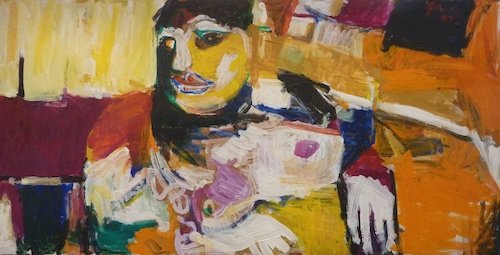Harold Garde

Harold Garde was born in New York City in 1923 and attended public schools with three years as a science major at the College of the City of New York. In Wyoming, on the GI Bill of Rights after three years in the military (Army Air Forces, with time spent in the Philippines) he worked for the art department as a student assistant and received his BA in Fine Arts. The faculty included the surrealist Leon Kelly, the abstract expressionist George McNeil and the geometric abstractionist Ilya Bolotowsky. Back in New York, he attended Columbia University and received his MA in Fine Arts and Art Education. He taught secondary school art for two years in Roselle, New Jersey before returning to New York City where he worked in commercial interior design.
In 1968, he became a professor, adjunct faculty Art Department at the Nassau Community College in Garden City, NY. He continued painting and exhibiting, and in 1971 in addition to the college teaching, he began full-time art teaching in the secondary school system of Port Washington, N.Y. In 1970, he had his first solo showing in Huntington, N.Y. and he continues to exhibit regularly. In 1984 he retired from teaching and moved to Belfast, Maine, with his second wife, the late writer, Barbara Kramer. Ten years later they bought their winter home in New Smyrna Beach, Florida. He continues to divide his time between homes and studios in Maine and Florida. He exhibits regularly in both states.
Garde has an abstract expressionist background. It was the most excitingly new development in art when he was a young painter. He is interested in what paint can do, making marks that expressively respond to his thoughts and actions. He rarely chooses to allow the non-figurative (the ‘abstract’ of “abstract expressionism”) to remain as the final work. From this first non-figurative stage he will continue working until he finds an image that becomes an identifiable subject. When he has decided on this image, then comes the careful exploring and developing needed to finalize each work, each with its own unique integrity.
Although he has enjoyed experiences with sophisticated techniques and equipment, he now strives for the simplest, the most direct, and the most basic. He works in acrylics because of the easy application when painting on paper or canvas. For more recent print-making, he has developed and taught his dry image transfer “strappo” technique. He relishes the effects he can create with the use of simple tools, acrylic paints, and glass plates.
There are themes that recur in his work and often re-emerge as current challenges. Although an individual work must be a unique statement, he welcomes a subject that invites a multitude of solutions. When that occurs, and he is concerned with a series, there is a helpful direction as he reaches for a solution. A new and separate version can be an answer to the puzzle that is every painting. Looking for a new solution to challenges and keeps him energized. The accumulation that results from these explorations can present to him, or viewers, a rewarding overview.
Over the years he has used as subjects the images of chairs, single and in groups. He has a pinnacle series, a series with still life references. There are some series that have figures and faces, puppeteers, and puppets. A group of recent works related to the “T” shape of the kimono. Such subjects, suitable for a series, attract him when they are generic, ones that are familiar, readily recognized, and capable of being rendered with many variations. Whether they are presented subtly or boldly, small or large, fragile or monumental, he wants his works to be visually exciting, capable of engaging the eye, the emotions, and stimulating the mind of the viewer.
